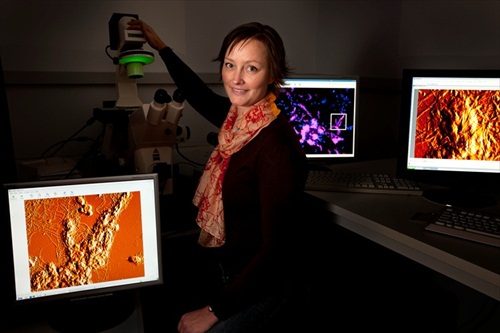Members Login

Channels
Special Offers & Promotions
JPK reports on the use of AFM and single-cell force spectroscopy at the Interdisciplinary Nanoscience Center at Aarhus University, Denmark
JPK Instruments, a world-leading manufacturer of nanoanalytic instrumentation for research in life sciences and soft matter, reports on the research studies of Dr Rikke Meyer who is looking into biofilm formation from bacteria using atomic force microscopy, AFM, and single-cell force spectroscopy
The interdisciplinary Nanoscience Center (iNANO) was formed by various research groups at Aarhus University together with groups from the Faculty of Science at Aalborg University. iNANO comprises facilities for the synthesis of nanostructured and nanopatterned 0D (i.e. nanoparticle), 1D, 2D and 3D materials.
The group of Dr Rikke Meyer works at the interface between microbiology and nanoscience in the quest to understand how bacteria form biofilms and how this may be prevented. AFM and optical microscopy are used to visualize bacterial cells and to study the interaction forces between cells and an abiotic substrate. AFM imaging and single-cell force spectroscopy are excellent tools to visualize detailed structures on the bacterial cell surface and to study how these contribute to cell adhesion to other substrates.
The motivation for using AFM in Dr Meyer's research was firstly to obtain detailed images of bacterial cells without extensive sample preparation. Furthermore, as she is interested in the interactions between bacteria and abiotic surfaces, she and her team use AFM force spectroscopy to quantify these interaction forces. AFM is one of several techniques used in these studies. These also include brightfield microscopy, fluorescence microscopy, confocal laser scanning microscopy, scanning electron microscopy and transmission electron microscopy.
Dr Meyer comments on her research and reasons behind her choice of AFM: "The coupling with optical microscopy is no doubt the feature that was most important for me in deciding to go with an AFM from JPK. As a microbiologist, I work with very heterogenous samples and it is not feasible to use AFM imaging to locate the field of interest, as large areas of the sample are often visualized to locate a site of interest. In the combined system, we can use the optical image to locate cells of interest before engaging the AFM for imaging or other measurements."
Continuing, she said, "AFM has mostly been used to study bacterial cells that are isolated in pure culture. However, the vast majority of the bacterial species we know to date have not been isolated and can only be studied in situ. Fluorescence labeling allows a rough identification of bacteria directly in the sample and fluorescence imaging can thus be used to locate cells of interest before AFM imaging begins. The combination of AFM with optical imaging is thus particularly important for the analysis of bacteria in environmental samples."
For more details about JPK's specialist products and applications for the bio and nano sciences, please contact JPK on +49 30533112070, or visit www.jpk.com
Media Partners



